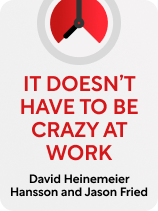

This article is an excerpt from the Shortform book guide to "It Doesn't Have to Be Crazy at Work" by David Heinemeier Hansson and Jason Fried. Shortform has the world's best summaries and analyses of books you should be reading.
Like this article? Sign up for a free trial here.
Why is hustle culture toxic? Is organizational growth always a good thing for business?
In today’s “hustle culture,” many workers end up ruining their lives in their attempts to get ahead in their careers. They sacrifice the time and energy they should be spending on their lives outside of work.
Keep reading to learn how organizations appeal to hustle culture and one solution for solving it.
Pursue Stable Success, Not Growth
In It Doesn’t Have to Be Crazy at Work, Jason Fried and David Heinemeier Hansson contend that hustle culture is toxic, yet many organizations perpetuate the unhealthy ideals of hustle culture through specific management strategies: Namely, they set aggressive quarterly growth targets to push their employees to do their best work. However, such uncompromising, growth-oriented goals needlessly create an unhealthy work environment that degrades employees’ quality of life.
To explain why, we’ll outline some of the downsides of aggressive organizational growth. Then, we’ll cover some of the benefits of the alternative strategy: aiming for stable, consistent success.
Downside #1: Growth Targets Are Demoralizing
First, Fried and Hansson say that growth targets demoralize employees by constantly moving the goalposts of what constitutes well-done work. As soon as the company achieves one arbitrary goal, it starts working toward the next one. This means that no matter how hard they work, employees can never feel relaxed or satisfied because there are always new targets requiring them to do better.
Downside #2: Growth Targets Create Financial Stress
Second, Fried and Hansson assert that aggressive growth targets put the whole company under financial stress, which puts every employee under emotional stress. Many startups spend far more money than they earn on expanding business as quickly as possible—intending to sacrifice short-term profits for long-term revenue growth. However, this strategy pressures the team to execute perfect work; if the company doesn’t hit its growth targets, it goes bankrupt. This pressure will cause your employees to quickly burn out.
Downside #3: Growth Targets Encourage Unethical Behavior
Finally, when companies make it their primary goal to hit growth targets, everyone on the team is more likely to break their promises to the customer and compromise their moral integrity to succeed. For example, in 2016, employees of the bank Wells Fargo who were under pressure to hit certain sales goals opened millions of fraudulent accounts under their customers’ names.
The Alternative: Stable Success
Instead of constantly setting bigger and more ambitious goals for your company, Fried and Hansson recommend defining success for your organization as the ongoing completion of the same stable goals. For instance, you may aim to deliver a product you’re proud of and provide great customer service. Settle into a work routine that makes your team happy and be satisfied with that—as long as the business is profitable, there’s no need to expand it to a scale that’s more stressful to manage. For example, if you run a landscaping business, make it your goal to serve a single city well season after season instead of expanding to manage teams across the country.
This doesn’t mean your organization can’t grow and progress—Fried and Hansson advocate refining and improving your workplace over time. Constantly stay on the lookout for ways to better accomplish your stable goals, as well as ways to make life for you and your employees as enjoyable as possible.
A Middle Ground: Profit First
If you’d like to strike a middle ground between traditional growth-centered business strategy and Fried and Hansson’s radical perspective of sticking to the same stable goals, consider using the “Profit First” method, as described by Mike Michalowicz in Profit First. Determine what percentage of revenue you want to save as profit before deciding how much revenue you want to reinvest in growth. Then, allow your company to grow as fast as it can without reinvesting more than you’ve allocated.
This strategy allows you to tackle ambitious goals while maintaining a cushion of profit to support the company and avoid painful cutbacks if business slows down. The more revenue you earn, the faster your company will grow—but the profits you set aside ensure you’re not spending more than you can afford.
You can also use these savings to support your company’s comfortable work routine, even as you grow—as Fried and Hansson would recommend. For example, if you want to offer your employees a four-day workweek, you can factor this into your expenses and only expand as you earn more than enough to support this perk.
Once you’ve set this system up, Michalowicz also recommends refining your workplace procedures over time. He expands on Fried and Hansson’s advice, suggesting that managers focus particularly on major sweeping changes rather than marginal refinements. For example, consider Netflix in 2007: Instead of looking for ways to make their DVD-by-mail service slightly more cost-effective (like developing more lightweight packaging), they developed an on-demand streaming platform that would make their company more valuable to consumers for years to come.

———End of Preview———
Like what you just read? Read the rest of the world's best book summary and analysis of David Heinemeier Hansson and Jason Fried's "It Doesn't Have to Be Crazy at Work" at Shortform.
Here's what you'll find in our full It Doesn't Have to Be Crazy at Work summary:
- How today's "hustle culture" ruins the lives of many
- How you can establish more reasonable and sustainable goals
- The three qualifications to look for when scouting for any potential hire






